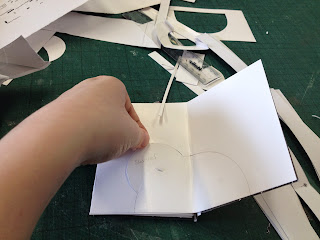Over the course of this module I pushed myself, I
wanted to achieve something complicated and refresh and expand upon
skills I'd learnt. With studio brief one I attempted a project which
I don't think I'd have dared to do in the previous year, making books
is something I do enjoy doing but increasing the complexity of the
binding process was a challenge that I took on joyfully. I enjoyed
the research process required throughout the module, not only into
science denial, which was very interesting to explore in depth, but
also with supporting research to create my final product. Researching
and experimenting were essential in making a successful piece and
this was one of the few modules I didn't trudge through it
begrudgingly, I genuinely liked making little experiments, comparing
my product to existing products on the market, understanding my
book's content and watching and reading videos and articles on
science denial, homeopathy and anti vaccination. I would be lying if
I said it was easy though, despite all my research and
experimentation I still produced two dud versions of the book and
three useless covers, picking myself up after something goes wrong
has always been an issue of mine, I'm more of a 'it has to go perfect
first time' kind of a person and so dealing with mistakes was new to
me. This project however, it didn't bother me anywhere near as much,
instead it was just a matter of saying 'ok, what went wrong this
time, what do I need to better next time?' and then applying it, each
time the book got better and better. Unfortunately the final book
still has some errors and due to lack on time and print slots I had
to call it enough, though I know now if I was going to produce it
again, it would be better still.
Throughout studio brief two I pushed my ideas
conceptually and my practical skills in production, I enjoyed pulling
away from illustrative responses and relying more on type, layout and
conceptual based visuals to solve the brief. It was enjoyable screen
printing again for this brief, although time consuming, it's a skill
that I don't want to loose and instead wanted to expand upon, I did
this by learning how to foil an image. I had worried with my final
design for this brief that could potentially be so simple it became
boring, however using foiling really added a subtle detail to the
piece and I think kept it intriguing yet minimal. I think I'm
beginning to break into a new style of design that isn't necessarily
reliant on my ability to illustrate, it's strange but rather freeing
to work with ideas and areas I wouldn't have considered previously. I
think I used my drawing ability as a crutch, although I'm good at it
I've begun to realise it's not an appropriate response to most of my
problems and instead I come out with stronger solutions when I apply
strong ideas and concept to a brief rather than trying to get some
form of drawing in there. Of course I say that and yet my book for
studio brief one is highly illustrative with less focus on layout and
type, it was more an exercise in construction than it was a strong
graphic piece of work, I don't think that matters too much though, it
would be impossible to create a children's pop up book and not
include illustrations somewhere. I think perhaps I was determined to
do one final big illustrative project before I put drawing on the
back burner to focus on other things, it was a good send off at
least.
Overall I like my work, and oddly I prefer my
response to studio brief two because it's none illustrative. I still
like the book, it's construction and final clean vector look does
appeal to me, but it's just a sign that I'm growing as a designer,
I'm gaining a style and I'm breaking away from a skill that I used to
rely on far too much that it prevented me from really growing. It's
exciting and I'm genuinely looking forwards to producing more graphic
based work over the summer and across the third and final year.















































